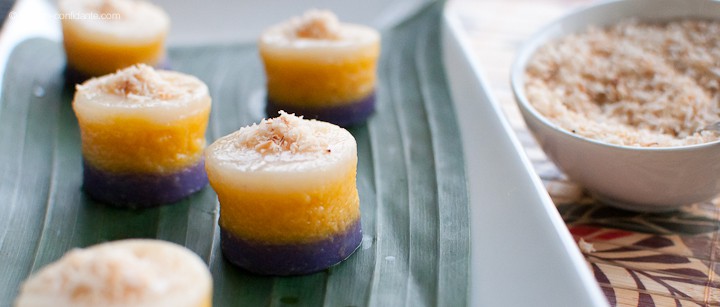
Sapin Sapin
Sapin-sapin is one example of the Philippine’s sweet delicacies made with glutinous rice. The literal translation of “layers,” sapin-sapin is made with sweet coconut milk and rice flour, and each layer has a different flavor. In my version, it is layers of cooconut, ube (purple…

Sapin-sapin is one example of the Philippine’s sweet delicacies made with glutinous rice. The literal translation of “layers,” sapin-sapin is made with sweet coconut milk and rice flour, and each layer has a different flavor. In my version, it is layers of cooconut, ube (purple yam or taro) and langka (jackfruit).
While most children beg for brownies, cupcakes and Rice Krispy Treats, ask my daughter what her favorite dessert is, and she will likely surprise you. Her most requested treat is a brightly hued, tri-colored delicacy, layered and sticky, and rich in sweet coconut flavors. And I will admit to you that it is with pride on my part that she favors the Filipino native dessert Sapin-Sapin, because it proves she is her mother’s daughter.
We both adore what is called kakanin in the Philippines, the word that is used to describe the delicacies made of glutinous rice, also known as malagkit (sticky). Other examples of kakanin include Suman, which is a specialty of my maternal grandfather’s province of Bicol, Bibingka, and Puto. Growing up, my favorite was Cuchinta (or Kutsinta), a brown rice cake served with freshly grated coconut. Any time we attend a family gathering where there is a table of these delicacies displayed, my little girl will happily fill her plate with a variety of them, but of them all, her favorite is the Sapin-Sapin.
I can’t blame her. The colors are vibrant and so appealing! Sapin-Sapin literally means “layers,” and although the whole dessert is made with sweet coconut milk and sticky rice flour, each layer may have a different flavor. Food coloring is typically the source of the pigment, but the deep violet color is usually flavored with real ube, or taro. Sometimes, the golden yellow is enhanced with sweet mais (corn) or langka (jackfruit).
She has been begging me to make Sapin-Sapin, and it’s not something I typically make. For me, kakanin is something you buy or order from a caterer. That’s just the way it is. But my daughter’s enthusiasm inspired me, and I became just as eager to make this dessert. My version uses not only ube (taro), but langka in the yellow layer, as well. I omit the traditional latik (a browned, caramelized coconut extracted from coconut cream) topping, and stick with just toasted coconut sugar as garnish, simply for personal preference.
The dessert was ready when my daughter came home from school last Friday and you should have seen her eyes light up at the sight of these translucent orbs of sticky goodness. I was pleased with how they turned out, and so was she. Even our cat stole a taste! It may be some time before we can plan a trip to visit the Philippines, but in the meantime, at least we’ll have Sapin-Sapin.
Sapin-Sapin
Sapin-sapin is one example of the Philippine’s sweet delicacies made with glutinous rice. The literal translation of “layers,” sapin-sapin is made with sweet coconut milk and rice flour, and each layer has a different flavor. In my version, it is layers of cooconut, ube (purple yam) and langka (jackfruit).
Ingredients
- banana leaves (optional) or parchment paper
- coconut oil or cooking spray
- 1 cup sweet rice flour (glutinous)
- 1 cup granulated sugar
- 1 13.5 oz can of coconut milk (gata)
- 1 14 oz can of condensed milk
- 1/4 cup canned ube (purple yam), drained
- 1/4 cup langka (jackfruit), canned or jarred, drained
- violet and yellow food coloring (If the idea of this bothers you, consider these vegetable based, natural food colorings. They are pricey, but might be worth it!)
- coconut sugar, for topping (see recipe below)
Instructions
Sapin-Sapin
A blender helps to achieve a smooth batter, however, if you do not have one, a whisk and some arm power will do just fine. You will also need a large pot/wok/steamer.
Prepare a dish (I used a spring-form pan) by lining the bottoms and sides with banana leaves or parchment paper. Brush lightly with coconut or canola oil, or spray lightly with cooking spray.
Whisk together rice flour and sugar. Add to coconut milk and condensed milk and blend (or whisk well) until smooth. Divide into three portions, about 1 1/3 cup each. Leave one portion white. Take the second portion and blend in the ube and a few drops of violet food coloring until you achieve a rich purple color. Take the third portion and do the same with the langka and yellow food coloring.
Prepare a steamer and set water to boil.
Beginning with the purple ube batter, pour into prepared pan/dish. Carefully place into the steamer and cover. Steam for about 30 minutes, or until an inserted toothpick comes out clean. Pour the yellow langka layer and steam for another 30 minutes or until set. Finally, pour the final white layer and steam 30 minutes or until set.
Carefully remove the Sapin-Sapin from the steamer and allow to cool completely. Chill in the refrigerator until ready to serve. Slice in wedges (or use a round cutter as I have), and serve with coconut sugar.
Coconut Sugar
- 1 cup coconut flakes
- 4 tablespoons sugar (to taste)
In a skillet over medium low heat, toast coconut flakes until just golden brown, stirring frequently. Add sugar and stir till you reach desired color.
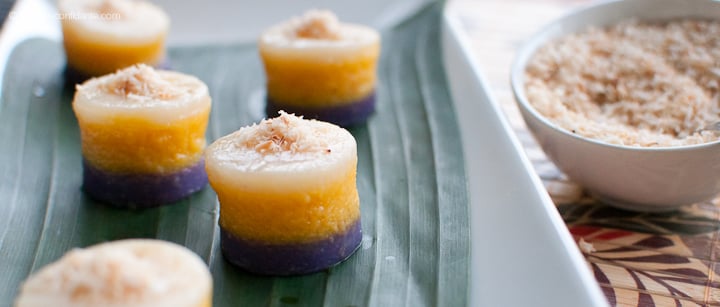

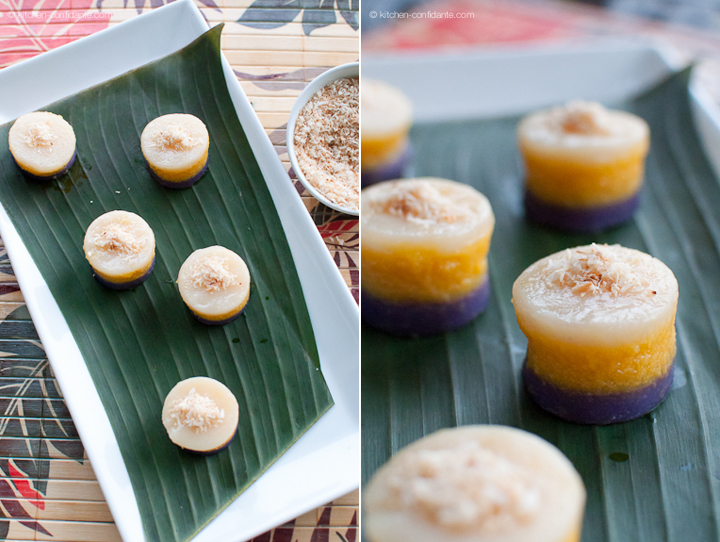
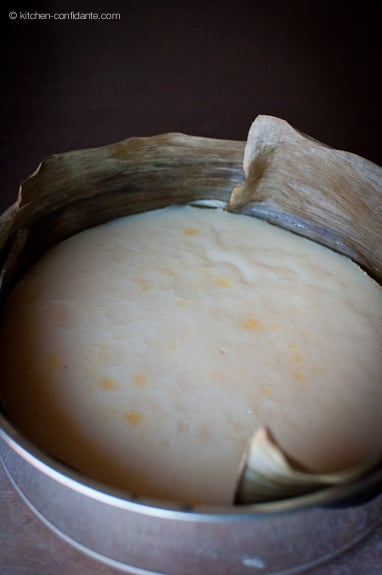









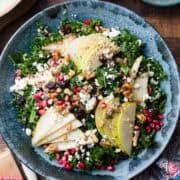







Sapin-Sapin (one of the most common pasalubong delicacies in the Philippines. I love your presentation, it is so kid friendly. No wonder your daughter is fond of these sticky-vibrant-colored orbs. Perhaps I should give it a try too. Cheers to Filipino cuisine/delicacy!
your daughter has great taste! i made this yesterday, it’s soo good, i say even better than the store bought ones. i didn’t have ube so i only have the langka layer and the plain one it turned out great so i’m sure even better with the ube layer. thank you so much for sharing this recipe, so glad i came across
ur blog! thanks again!
I’d like to attempt this and your recipe has been one of the least intimidating I’ve come across. But I do have a couple questions I hope you can answer.
A lot of the recipes I’ve looked up specify using glutinous rice flour. Your’s does not specify and I’m wondering if makes a difference either way? Also I wonder if you would know if brown rice flour works as well?
I am also wonder where you get your canned Ube? Do you order it online? If so, Can you post a link to the site?
Thanks for your help!!!!
Hi MZ,
Yes, ideally, sweet rice flour, or glutinous rice flour, is ideal in this recipe. I will have to update the recipe to reflect that. You can see the kind I used in this link: http://www.thekitchn.com/whats-the-difference-rice-flou-137190 – the Mochiko Sweet Rice Flour works well here. I have never tried brown rice flour, so unfortunately can’t speak to that.
I found my canned ube at an Asian market called 99 Ranch Market (www.99ranch.com/). You may have one near you. Also look in the frozen food section of your local Asian market, sometimes they have it there too.
Hope this helps, and good luck!
How beautiful! They sound delicious….
Those are just lovely and I bet your daughter was quite pleased :)
I feel like I’ve had this before, it evokes a vague memory, but I’ve never been to the Philippines so possibly it’s a false memory…? Something similar in some other cuisine, perhaps…
Regardless, it’s beautiful. If I were your daughter I’d want it too ;)
Jax x
I love it. Your daughter takes after you (in more ways than one, I’m sure!) Not only do these look stunning, but they must taste amazing. I’ve never tried something like this before, but now I’m eager to try making some of my own! Thank you for sharing with me tonight. I hope you have a great Friday. I’m so ready for the weekend!
What a wonderful dessert. I’m right there with your daughter. Although I’ve never had one of these treats, I’m loving the flavor combinations. And how beautiful they are all vibrant and layered. Thanks for educating me, Liren. I’m bookmarking these special treats!
now I have never heard of those little beauties, but if your daughter loves them they must be incredible! That coconut sugar sounds delicious I could eat that all by itself!
Cheers
Dennis
I’ve never seen this dessert before but I am totally enchanted by its appearance…and being a fan of coconut, I imagine I’d like the taste too!
I have been dying for a good sapin sapin recipe. Thank you so much for sharing. it looks wonderful.
Such gorgeous sapin sapin! Those little rounds are so cute! I love the flavours you’ve used. I can almost taste it.
Absolutely lovely. My granddaughter is part philippino and she also goes for her sweet deserts from her Mom’s side.
gorgeous decadent dessert! My best friend Ann is Fillipino, I just e-mailed her a link to your beautiful blog! :)
Beautiful photos! I can see why these are your daughter’s favorite dessert, not only do they have the sweet flavor but they are sooo pretty to look at :)
It certainly is an elegant dessert, it’s wonderful that your daughter is learning about her heritage and enjoying these desserts.
Hi Sylvie! I do think it is an elegant dessert…but it certainly has the most humble ingredients. I love the ingenuity of Filipino cuisine!
So beautiful! My mom loves these…
Thank you so much, Jun!
Coconut jackfruit taro condensed milk – all of my absolute favorites! How is it possible that I have not tried this dish before? I can’t wait to try it! It looks amazing!
If you love all of those flavors, then you will go ga-ga over Sapin-Sapin! I hope you try it soon!
I hear you! Big mom’s pride moment and you have every right! I hope one day, when I will have kids, they will ask me for some Italian treats instead of pb&j or other American thing. Plus, I have never had sapin-sapin but it’s so so so appealing with those layers of colors! I’m glad you made your daughter happy and you shared the recipe with us
Hi Sara, I’m am certain that your kids will look back at your Italian treats with the most affection! There really is something special about passing on traditions and heritage, through food.
oh, this reminds me of when my mom used to bring home bibingka to me when i was little! what a lovely memory and how wonderful you are creating these memories with your daughter! my husband’s family is from the philippines (and many still there) and he can remember his mom eating this when he was little. i often make a coconut cake (using mochi flour) to get my fix.
Dina, you mention one of my all time favorites! I adore bibingka and it’s another recipe I can not wait to make very soon! Your coconut cake sounds so good – is it sticky from the mochi flour?
Mama’s girl knows what is good for her! :) I love sapin – sapin! I tried it years ago and swallowed it up in seconds…it’s so good. Thank you for the recipe…I hope that I can make it as good as yours.
Hi Kate! I’m so glad you have tried sapin-sapin before – and even happier that you liked it! I hope this one lives up to the one you tasted :)
Hi Liren! Thank you for gracing our first PinoyFoodista In Spotlight and for sharing this recipe with us. As always, your passion and sincerity shines through in any dish you create. The Sapin-Sapin looks yummy and in my humble take, I think it looks better than the local versions we have here :) Thanks again and more power!
Jan, the honor is all mine. Thank you so much for featuring me, my recipes and this Sapin-Sapin on PinoyFoodista! It really means so much to me, and I am looking forward to seeing what the future holds for PinoyFoodista!
I have discovered something new here today, Liren. I have never had Sapin-Sapin, and am now completely committed to trying this. They are so colorful. I don’t know that mine will look quite so pretty…
Knowing you, Debi, I am certain that when you try Sapin-Sapin they will be absolutely beautiful! Let me know how it turns out!
My love of kakanin will be the ruin of me (or rather, my diet)! What a lovely presentation of sapin-sapin – your daughter certainly has good taste, taking after Mom, of course. A future food blogger, perhaps? 8-)
You never know what these little guys will turn out to be, but who knows? I will say, she has an amazing sense of taste. She can detect the slightest hint of ingredients, better than me sometimes. And when she sniffs the wine cork, she will give a pretty accurate representation of the wine, without a single taste. So…who knows?
These look wonderful! I am also Filipina, but because I am away from my family, I don’t get to eat as much Filipino food as I used to. I love seeing these desserts posted so others can enjoy!!
These are so pretty! I can see why she asks for it!
The moment you said that this is ur girl’s favorite dessert, I was sold! The recipe is very new to me and I’ve never tasted it before but the process and ingredients are something I’m familiar with so I hope I’ll be able to pull it off. Trying this for sure! BOOKMARKED :-)
So glad you made these, Liren–they’re beautiful. I’m not well-versed on filipino sweet treats (except for maja blanca which I hope to try soon) but I think my mom would be happy to adopt you as her fourth daughter for making these! I’ll have to direct her to your blog so she can see this post. Like you, she’s ordered filipino sweets more than make them but I have to say she’s liking baking more and more these days. She’ll really like these and I know I will too. There’s ube! I love it!
Those are stunning and such a wonderful thing to share with your daughter… a wonderful way to bring some of your Phillipinian heritage into her life.
And I LOVE that I just learned some words in the process. Another lovely post!
Liren, first obviously your daughter has a very discriminating taste. My son also one of his favorites is an Indian desserts we churn for a long time on the stove. Just when I think you outdid yourself you present us with this beautiful creation. I take so much joy discovering people’s culture through their food so very well done here!!